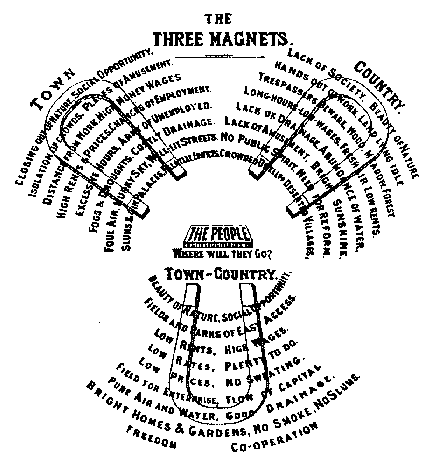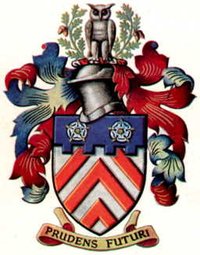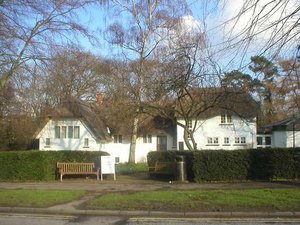Letchworth
|
|
Template:GBdot Letchworth, officially Letchworth Garden City, is a town in Hertfordshire, England. The town's name is taken from one of the three villages it surrounded. Founded in 1903, it was one of the first new towns, and calls itself the world's first Garden City. Its development inspired another Garden City project at Welwyn, and had great influence on future town planning and the New Towns movement. Today it has a population of around 33,000.
| Contents |
The town's development
The early days
In 1898, the social reformer Ebenezer Howard wrote a book entitled Tomorrow: A Peaceful Path to Real Reform (later republished as Garden Cities of Tomorrow), in which he advocated the construction of a new kind of town, summed up in his Three Magnets diagram as combining the advantages of cities and the countryside while eliminating their disadvantages. Industry would be kept separate from residential areas-- such zoning was a new idea at the time-- and trees and open spaces would prevail everywhere. His ideas were mocked in the press but struck a chord with many, especially members of the Arts and Crafts movement.A competition was held to find a town design which could translate Howard's ideas into reality, and within a few years the company "First Garden City Ltd." was formed, Barry Parker and Raymond Unwin were appointed architects, and 16 km² of land outside Hitchin were purchased for building. In 1905, and again in 1907, the company held the Cheap Cottages Exhibitions, contests to build inexpensive housing, which attracted some 60,000 visitors.
Railway companies often ran excursions to the town, bringing people to marvel at the social experiment and sometimes to mock it: Letchworth's founding citizens, attracted by the promise of a better life, were often caricatured by outsiders as idealistic and otherworldly. John Betjeman in his poems Group Life: Letchworth and Huxley Hall painted Letchworth people as earnest health freaks. One commonly-cited example of this is the ban, most unusual for a British town, on selling alcohol in public premises. This was not lifted until a referendum in 1958.
One of the most prominent industries to arrive in the town in the early years was the manufacture of corsets: the Spirella Company began building a large factory in 1912, close to the middle of town and the railway station that opened the next year. The Spirella building, completed in 1920, blends in despite its central position through being disguised as a large country house, complete with towers and a ballroom. During the Second World War, the factory was also involved in producing parachutes and decoding machinery. Because corsets fell out of fashion, the factory closed in the 1980s, and was eventually refurbished and converted into offices. Another significant employer in the town was Shelvoke and Drewry, a manufacturer of dustcarts and fire engines which existed from 1922 until 1990.
Amy Rose and the takeover bid
One of Letchworth's founding principles, unlike any previous British attempt at new town design, was that land should be held in common for the good of all. First Garden City Ltd owned the entire estate, but leased plots to citizens for building houses, to farmers for growing crops, and so on. The rents would provide income for the company, which would then invest the money back into the community. All citizens were shareholders, so all money was invested for the common good, and developments which the citizens disliked (tower blocks, for example) could be restricted as they pleased.
This arrangement began to go wrong in 1961, when Amy Rose and a company named Hotel York Ltd realised that if it bought enough of the shares from the citizens it could have a controlling interest in the town's estate, with no guarantee that the money would be used for the common good. To remedy this, Parliament passed the Letchworth Garden City Act 1962, which created a public body, the Letchworth Garden City Corporation, to take on the business of First Garden City Ltd; as a statutory corporation it could not be bought. The Corporation's officers were appointed by the Crown; later, the Letchworth Garden City Heritage Foundation Act 1995 replaced the Corporation with a charity, the Foundation, whose officers were appointed by local residents.
Many of the original ground leases were written to last for nine hundred and ninety-nine years, but some ran for only ninety-nine; around 2001 many of these shorter leases began to expire, whereupon the Foundation sold the freehold of the land to the houseowners.
The civic local government of Letchworth has always been separate from the Company, Corporation or Foundation. It was formerly the responsibility of the Letchworth Urban District Council. After that body's abolition in 1974, local government became the responsibility of the North Hertfordshire District Council. However, in December 2003 a referendum showed 60% in favour of creating a town council in addition to the district council; elections to the new body were held in late May 2005. All members of the new council are independent of any political party.
Letchworth today
Several housing estates have been added to Letchworth since its inception: the Grange in 1947, Jackmans in 1961, and the more prosperous Lordship Farm and Manor Park in 1971. However, Jackmans is rather cut off from the rest of the town by major roads.The Garden City estate began to turn a profit in the 1970s, leading to investment in a number of town amenities: a working farm, Standalone Farm, in 1980, a leisure centre and a theatre named Plinston Hall in 1982, a free hospital (the Ernest Gardiner Day Hospital) in 1984, and major refurbishment of the town's cinema and shopping centre in 1996 and 1997. The Foundation celebrated the town's centenary in 2003 by building a landscaped path for walkers and cyclists. The path, known as the Greenway, forms a 20km loop around the town.
External links
The town's government
- Letchworth tourist guide (http://www.letchworthgc.com)
- Letchworth Garden City Heritage Foundation (http://www.lgchf.com)
- Hansard debate on the Heritage Foundation bill (http://www.parliament.the-stationery-office.co.uk/pa/ld199495/ldhansrd/vo950208/text/50208-10.htm)
- NHDC's page about the proposed Letchworth Town Council (http://www.north-herts.gov.uk/news/news.asp?step=4&NewsID=499)
- Campaign in favour of creating Letchworth Town Council (http://www.letchworthgctowncouncilcampaign.co.uk)
Facilities
- The Spirella building (http://www.spirella.com)
- The Plinston Hall (http://www.plinstonlive.com/)
- The Garden City Greenway (http://www.greenway.org.uk/)
Photographs
- Photographs of buildings in the town (http://andrew.publication.org.uk/photos/letchworth/)
- A photographic tour of the town (http://www.letchworthgardencity.net/heritage/tour/letchworthplan.htm)
Other
- A Guardian article about the history of the town (http://www.guardian.co.uk/britain/article/0,2763,1096952,00.html)



